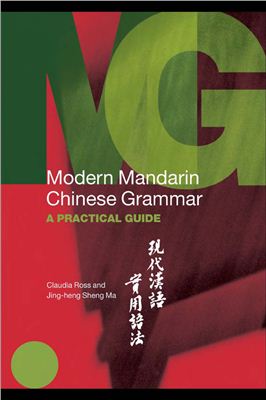Routledge, 2006 — 432 p.
Справочник и сборник упражнений по современной грамматике
китайского языка (путунхуа, он же гоюй, он же мандарин). Основной
текст - на английском языке. Особенности: - все примеры приведены
как упрощёнными, так и традиционными иероглифами, а также
пиньином;
- также приведены примеры, специфичные для Тайваня и юга Китая. This book is divided into two sections: ‘Structures’ and ‘Situations and functions. ’
Part A ‘Structures’ is a concise grammar of Mandarin Chinese organized in the familiar
and traditional way, providing an overview of the Chinese writing system and de-
scribing the major features of Mandarin grammar. This section should be used for
reference when you want to know something about a form or structure. For example,
if you want to review the structure of the noun phrase, or how to form numbers, or
the structure of the passive form, you should consult this section.
Part B ‘Situations and functions’ is organized in terms of how to do things with
language, and it is the longer of the two sections. For example, if you want to know
how to address someone, how to say ‘no, ’ how to make comparisons, or how to
apologize, you should consult this section.
Often, the same ground is covered in both parts of this book, although the emphasis
is different in each section. Related sections are linked by cross-referencing, indicated
by arrows in the margin of the page directing you to another section. Related func-
tions are also cross-referenced throughout the book. You should always follow the
cross-reference links so that you have a complete picture of the expression that you
are exploring and can use it correctly and accurately.
Topics covered in this book are listed in the table of contents and in the index, and
you should use them to help you find words and topics quickly and easily. Notice
that the index is an alphabetical listing that includes keywords in English and in
Pinyin romanization. For example, if you want to know how to indicate that you
have had an experience in the past you can look in the index for the English
expression ‘experience in the past’ or for the Pinyin word guo.
In this book, we use traditional grammatical terms to explain the structures of
Mandarin. The terms are presented in the glossary at the beginning of this book.
Once you are familiar with the grammatical terms you will find them helpful in
understanding the grammar and in expressing yourself accurately.
We hope that you will find this book useful and informative. We look forward to
leaing how you use the book, and to receiving your suggestions on how it can be
improved.
Claudia Ross and Jing-heng Sheng Ma
- также приведены примеры, специфичные для Тайваня и юга Китая. This book is divided into two sections: ‘Structures’ and ‘Situations and functions. ’
Part A ‘Structures’ is a concise grammar of Mandarin Chinese organized in the familiar
and traditional way, providing an overview of the Chinese writing system and de-
scribing the major features of Mandarin grammar. This section should be used for
reference when you want to know something about a form or structure. For example,
if you want to review the structure of the noun phrase, or how to form numbers, or
the structure of the passive form, you should consult this section.
Part B ‘Situations and functions’ is organized in terms of how to do things with
language, and it is the longer of the two sections. For example, if you want to know
how to address someone, how to say ‘no, ’ how to make comparisons, or how to
apologize, you should consult this section.
Often, the same ground is covered in both parts of this book, although the emphasis
is different in each section. Related sections are linked by cross-referencing, indicated
by arrows in the margin of the page directing you to another section. Related func-
tions are also cross-referenced throughout the book. You should always follow the
cross-reference links so that you have a complete picture of the expression that you
are exploring and can use it correctly and accurately.
Topics covered in this book are listed in the table of contents and in the index, and
you should use them to help you find words and topics quickly and easily. Notice
that the index is an alphabetical listing that includes keywords in English and in
Pinyin romanization. For example, if you want to know how to indicate that you
have had an experience in the past you can look in the index for the English
expression ‘experience in the past’ or for the Pinyin word guo.
In this book, we use traditional grammatical terms to explain the structures of
Mandarin. The terms are presented in the glossary at the beginning of this book.
Once you are familiar with the grammatical terms you will find them helpful in
understanding the grammar and in expressing yourself accurately.
We hope that you will find this book useful and informative. We look forward to
leaing how you use the book, and to receiving your suggestions on how it can be
improved.
Claudia Ross and Jing-heng Sheng Ma

